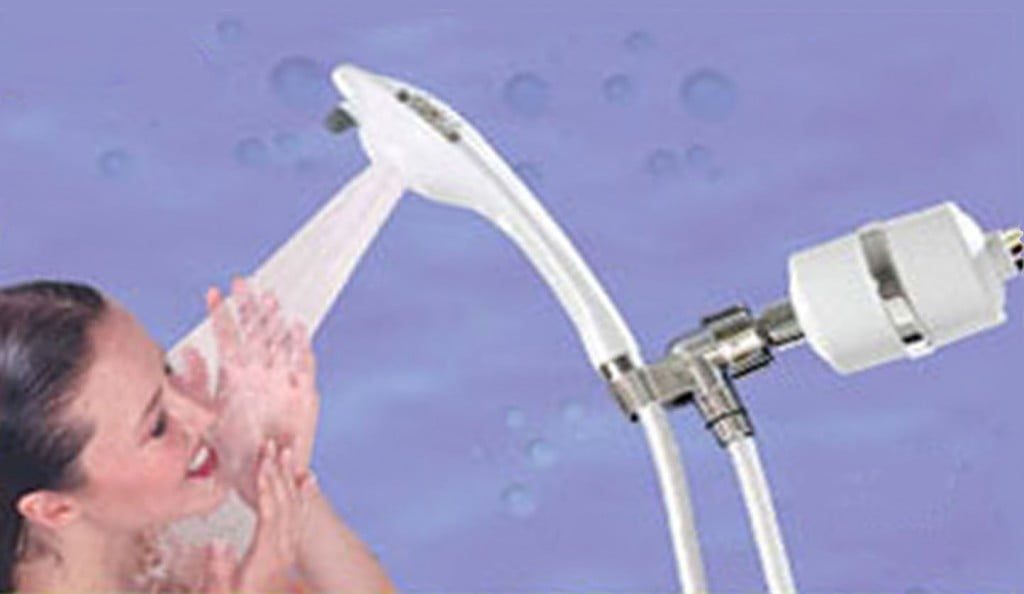Φίλτρο ντους
Οι μακροπρόθεσμες επιδράσεις του πόσιμου χλωριωμένου νερού αναγνωρίζονται απλώς. Σύμφωνα με το Συμβούλιο Περιβαλλοντικής Ποιότητας των ΗΠΑ, "ο κίνδυνος καρκίνου μεταξύ των ατόμων που πίνουν χλωριωμένο νερό είναι 93% υψηλότερος από εκείνους των οποίων το νερό δεν περιέχει χλώριο".
 Υπάρχουν πολλές καλά θεμελιωμένες ανησυχίες για το χλώριο. Όταν το χλώριο προστίθεται στο νερό μας, συνδυάζεται με άλλες φυσικές ενώσεις για να σχηματίσουν τριαλομεθανές (υποπροϊόντα χλωρίωσης) ή THMS. Αυτά τα υποπροϊόντα χλωρίου προκαλούν την παραγωγή ελεύθερων ριζών στο σώμα, προκαλώντας κυτταρική βλάβη και είναι εξαιρετικά καρκινογόνες. "Αν και οι συγκεντρώσεις αυτών των καρκινογόνων (THMs) είναι χαμηλές, είναι ακριβώς αυτά τα χαμηλά επίπεδα που οι επιστήμονες του καρκίνου πιστεύουν ότι είναι υπεύθυνοι για την πλειονότητα των ανθρώπινων καρκίνων στις Ηνωμένες Πολιτείες". Το Ταμείο Περιβαλλοντικής Άμυνας.
Υπάρχουν πολλές καλά θεμελιωμένες ανησυχίες για το χλώριο. Όταν το χλώριο προστίθεται στο νερό μας, συνδυάζεται με άλλες φυσικές ενώσεις για να σχηματίσουν τριαλομεθανές (υποπροϊόντα χλωρίωσης) ή THMS. Αυτά τα υποπροϊόντα χλωρίου προκαλούν την παραγωγή ελεύθερων ριζών στο σώμα, προκαλώντας κυτταρική βλάβη και είναι εξαιρετικά καρκινογόνες. "Αν και οι συγκεντρώσεις αυτών των καρκινογόνων (THMs) είναι χαμηλές, είναι ακριβώς αυτά τα χαμηλά επίπεδα που οι επιστήμονες του καρκίνου πιστεύουν ότι είναι υπεύθυνοι για την πλειονότητα των ανθρώπινων καρκίνων στις Ηνωμένες Πολιτείες". Το Ταμείο Περιβαλλοντικής Άμυνας.
Στα τέλη του 1800 άρχισε να προστίθεται στο πόσιμο νερό. Αυτό έγινε το πρότυπο στην επεξεργασία του νερού μέχρι το 1904 και παραμένει σήμερα. Προστίθεται στο νερό για να σκοτώσει τα βακτήρια, τους ιούς και άλλους οργανισμούς που μπορούν να προκαλέσουν ασθένειες όπως τυφοειδές, χολέρα, δυσεντερία και άλλοι. Δεν χρησιμοποιείται σήμερα επειδή είναι η μόνη διαθέσιμη μέθοδος ή επειδή είναι το ασφαλέστερο ή πιο αποτελεσματικό μέσο για την απολύμανση του νερού μας. Χρησιμοποιείται επειδή είναι το φθηνότερο. Παρόλο που έχουμε κάνει μεγάλα βήματα στην τεχνολογία, προσθέτουμε ακόμα λευκαντικό στο νερό που πίνουμε.
Το απλά δηλωμένο χλώριο είναι ένα φυτοφάρμακο, όπως ορίζεται από την Ε.Π.Α. των ΗΠΑ, του οποίου ο μοναδικός σκοπός είναι να σκοτώσουν τους ζωντανούς οργανισμούς.
Ο καρκίνος του μαστού, ο οποίος επηρεάζει τώρα μία στις οκτώ γυναίκες στη Βόρεια Αμερική, έχει πρόσφατα συνδεθεί με τη συσσώρευση ενώσεων χλωρίου στον ιστό του μαστού. Μια μελέτη που διεξήχθη στο Χάρτφορντ Κονέκτικατ, το πρώτο από το είδος της στη Βόρεια Αμερική, διαπίστωσε ότι "οι γυναίκες με καρκίνο του μαστού έχουν 50% έως 60% υψηλότερα επίπεδα οργανοχλωρίδια (υποπροϊόντα χλωρίωσης) στον ιστό του μαστού από τις γυναίκες χωρίς καρκίνο του μαστού".
Ίσως το πιο συγκλονιστικό συστατικό σε όλες αυτές τις μελέτες είναι ότι μέχρι τα δύο τρίτα της επιβλαβούς έκθεσής μας στο χλώριο οφείλεται στην εισπνοή ατμού και απορρόφησης του δέρματος ενώ ντους. Ένα ζεστό ντους ανοίγει τους πόρους του δέρματος και επιτρέπει την επιτάχυνση της απορρόφησης χλωρίου και άλλων χημικών ουσιών στο νερό. Ο ατμός που εισπνέουμε ενώ το ντους μπορεί να περιέχει έως και 50 φορές το επίπεδο των χημικών ουσιών ως νερό της βρύσης. Το χλώριο και οι περισσότεροι άλλοι μολύνσεις εξατμίζονται πολύ πιο γρήγορα και σε χαμηλότερη θερμοκρασία από το νερό. Η εισπνοή είναι ένα πολύ πιο επιβλαβές μέσο έκθεσης, αφού το αέριο χλωρίου (χλωροφόρμιο) εισπνέουμε πηγαίνει κατευθείαν στο αίμα μας. Οι ατμοί χλωρίου είναι γνωστό ότι είναι ισχυροί ερεθιστικοί στον ευαίσθητο ιστό και τα βρογχικά περάσματα μέσα στους πνεύμονες μας, χρησιμοποιήθηκε ως πολύ αποτελεσματικό χημικό όπλο στον Παγκόσμιο Πόλεμο. Η εισπνοή του χλωρίου είναι μια ύποπτη αιτία άσθματος και βρογχίτιδας, ειδικά στα παιδιά ... που αυξήθηκε κατά 300% τις τελευταίες δύο δεκαετίες. Τα καυτά ντους είναι ύποπτα ως η κύρια αιτία αυξημένων επιπέδων χλωροφόρμιο σε σχεδόν κάθε σπίτι λόγω χλωρίου στο νερό.
Οι τεκμηριωμένες επιστημονικές μελέτες καταλήγουν στο συμπέρασμα ότι η λήψη καυτών ντους (κάτω από το χλωριωμένο νερό) μπορεί να είναι κίνδυνος για την υγεία. Το σώμα μας μπορεί να απορροφήσει περισσότερο χλώριο ως αποτέλεσμα ενός ντους 10 λεπτών απ 'ό, τι εάν κάποιος έπινε οκτώ ποτήρια του ίδιου νερού. Ένα ζεστό ντους ανοίγει τους πόρους του δέρματος και αναγκάζει το δέρμα να δρα σαν σφουγγάρι. Ως αποτέλεσμα, το χλώριο εξατμίζεται και εισπνέεται και απορροφάται μέσω του δέρματος, απευθείας στην κυκλοφορία του αίματος - με ρυθμό που είναι έως δέκα φορές υψηλότερος από το πόσιμο. Βραχυπρόθεσμα, το χλωριωμένο νερό ερεθίζει τους κόλπους, το λαιμό, το δέρμα και τους πνεύμονες. Οι μακροπρόθεσμοι κίνδυνοι περιλαμβάνουν σκληρυμένες αρτηρίες, υψηλότερη ευπάθεια στις γενετικές μεταλλάξεις και δυσκολίες στη μεταβολισμό της χοληστερόλης.
Δεν είναι ρεαλιστικό να πιστεύουμε ότι θα μπορούσαμε να καταργήσουμε το χλώριο κάθε φορά στο εγγύς μέλλον. Είναι επίσης σαφές ότι το χλώριο αντιπροσωπεύει μια πολύ πραγματική και σοβαρή απειλή για την υγεία μας και πρέπει να αφαιρεθεί στα σπίτια μας, στο σημείο χρήσης, τόσο από το νερό που πίνουμε όσο και από το νερό που ντους μέσα. Καλέστε μας για μια πλήρη λύση.
[1-click-image-ranker]
- Πώς χρησιμοποιείτε το SodaStream Duo – Οδηγός βήμα προς βήμα; - 6 Φεβρουαρίου 2024
- Γιατί να επιλέξετε συστήματα χωρίς δεξαμενή; Ανακαλύψτε τα καλύτερα συστήματα αντίστροφης όσμωσης χωρίς δεξαμενή στην Κύπρο - 18 Δεκεμβρίου 2023
- Σύγκριση χλωρίου έναντι διοξειδίου του χλωρίου: Ποιο είναι το ανώτερο απολυμαντικό; - 25 Ιουνίου 2023
